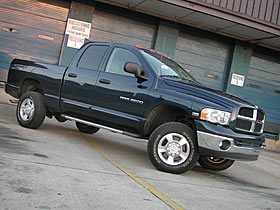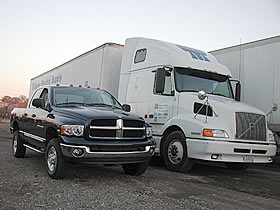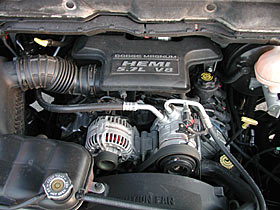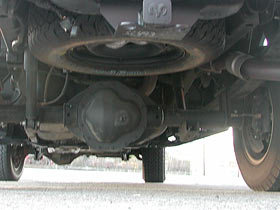|
|
||||||||||||||||||||||||||||||||||
"HEMI®."
Just saying the word makes you feel powerful. Try it.
HEMI. Feels good, doesn't it? Those motorheads in the latest Dodge commercials sure think so, anyway. With a heritage dating back to the 1930s, the HEMI engine began life as a liquid-cooled aircraft engine. Chrysler's engineers had developed a supercharged and turbocharged upside-down V-16 to battle Rolls-Royce's Merlin engine, used in the Spitfire aircrafts, among others. The name came from the hemispherical design of the the cylinder head.
Though considered to be a great engine, the 180 hp FirePower V-8 would last in production for only eight years. At the end of its run, it had grown to be a 392 and put out 390 hp. A racing version was tested in 1952, but was banned for use in the Indy 50 because its speed would outrun the rest of the field. The HEMI made other showings, such as the 276 c.i.d. used in DeSotos, and later, a 241 c.i.d. "Red Ram" used by Dodge from 1953 through 1957. This model finished its production life as a 325 c.i.d. But the one HEMI that everyone thinks of first, was of course, the 426 Race HEMI. Former models were dropped from production because of their complex (read, expensive) design compared to their competition. Instead, Dodge was making simpler engines bigger, despite being less efficient than their predecessors. But by the early 60's, Chrysler was losing too many races at the track. Their NASCAR dominance of yesterday had waned and they were eager to regain the top position. What would get them there was the HEMI. The 426 c.i.d. was built. The race version featured high-flow heads, tubular headers, a potent 12.5:1 compression ratio, and a single, four-barrel carburetor. Plymouth and Dodge once again became top finishers, proving that what won on Sunday, sold on Monday.
So why the long history lesson on the HEMI? Well, in case you've been living under a rock lately, Dodge's new 2500 and 3500 Heavy Duty pickups now feature the HEMI as the standard engine. Not only that, but the HEMI is also set to be available in 2003.5 Ram1500 pickups, the 2004 Dodge Durango and possibly even other models, including cars, in the DaimlerChrysler lineup. Not nearly as large as the big blocks of old, the new HEMI is a 345 c.i.d. engine. The eight cylinders (16 valves) run a 9.6:1 compression ratio and crank out 345 hp (5400 rpm) and 375 lb.-ft of torque (4200rpm). This represents a 41% power gain and 12% greater torque than the 5.9L Magnum V-8 it replaces. See the chart below to see how this compares to the other gas-burning motors on the market today.
Studying the chart, each manufacturer's engines horsepower and torque peak at different rpm ranges, so without actually driving each one in a comparable truck, it's difficult to say which would be the "best" motor. If we simply look at the peak values alone, you can see the HEMI is quite the leader in the V-8 range in horsepower and second only to the big block GMC engine. The V-10s, of course, are the torque monsters and beat all, but the HEMI is near the top of the class once again in the V-8s. Where the HEMI is the big winnerl is in the all-around numbers, and being a smaller motor than the V-10s means less of that recommended 89 octane will be purchased each time you visit the gas pump. Where the HEMI does get outclassed is in the towing realm, where the diesel motors rule the landscape with their massive 500+ torque values. But we're talking about gas engines here, aren't we? The
2003 Dodge Ram Heavy Duty Pickups (click
photos for larger views) While the 2WD versions use a new rack and pinion steering design, the 4WD versions use a redesigned recirculating ball steering setup. The result is much better steering feel, especially when coupled with the new 17 x 8 inch wheels. The 4WD Rams have a 13.4:1 overall steering ratio and 2.75 turn lock-to-lock. Though not nearly as tight a circle (what is?) as GMC's Quadrasteer trucks, the new Rams are much more maneuverable than previous models - especially when in tight spots. Inside the new frame resides one of four available transmissions, those being:
Carrying the weight of a full-size pickup is a daunting task and the new Heavy Duty Rams feature a new suspension system in the 4WD versions. The front suspension is a modified version of the five-link, coil-spring suspension used on previous HD Rams with a new front beam axle. Clearance below the axle is 8.7 inches. The rear suspension is common to both 2WD and 4WD models and uses longitudinal leaf springs, lengthened three inches from the 2002 versions to improve ride quality. The 2500's two-stage springs have three leaves for normal loads and an additional leaf for heavy hauling. The rear box section was also widened to create a wider rear spring span, which also helps combat lean during cornering. These changes actually eliminated the need for a rear stabilizer bar. All-new axles also adorn the new Rams. The 2500 series' axles use a 10.5 inch ring gear (11.5 inch on the 3500) in the rear and a 9.26 inch in the front. These big-boy axles help the Rams get a best-in-class towing rating in the 3500 diesel models (12,000 pounds). Upgrading the standard 3.73:1 axle ratio to 4.10:1 nets an additional 2,000 pounds of towing capacity. 13.9" disc brakes with ABS are at all four corners.
|
||||||||||||||||||||||||||||||||||

 "Hey!
That thing got a HEMI?"
"Hey!
That thing got a HEMI?" In
1951, "the dual rocker" 331 c.i.d. motor appeared in Chrysler
cars. The theory behind the motor (and any motor) was that the easier
an engine breathes, the greater its volumetric efficiency and the
more power it produces. The hemispherical combustion chamber design
allows large valves to be located across from each other instead
of side-by-side, which creates cross flow and free flow between
the intake and exhaust ports. What that means is a more complete
burning of the air/fuel mixture coming from a central spark plug,
located close-by. The design also minimized heat loss, which in
turn, means more energy. The name "hemispherical" comes
from the fact that the smallest amount of space that can contain
a given volume is a sphere. A hemispherical combustion minimized
the surface area, thus minimized heat loss.
In
1951, "the dual rocker" 331 c.i.d. motor appeared in Chrysler
cars. The theory behind the motor (and any motor) was that the easier
an engine breathes, the greater its volumetric efficiency and the
more power it produces. The hemispherical combustion chamber design
allows large valves to be located across from each other instead
of side-by-side, which creates cross flow and free flow between
the intake and exhaust ports. What that means is a more complete
burning of the air/fuel mixture coming from a central spark plug,
located close-by. The design also minimized heat loss, which in
turn, means more energy. The name "hemispherical" comes
from the fact that the smallest amount of space that can contain
a given volume is a sphere. A hemispherical combustion minimized
the surface area, thus minimized heat loss. Meet
Today's HEMI
Meet
Today's HEMI


